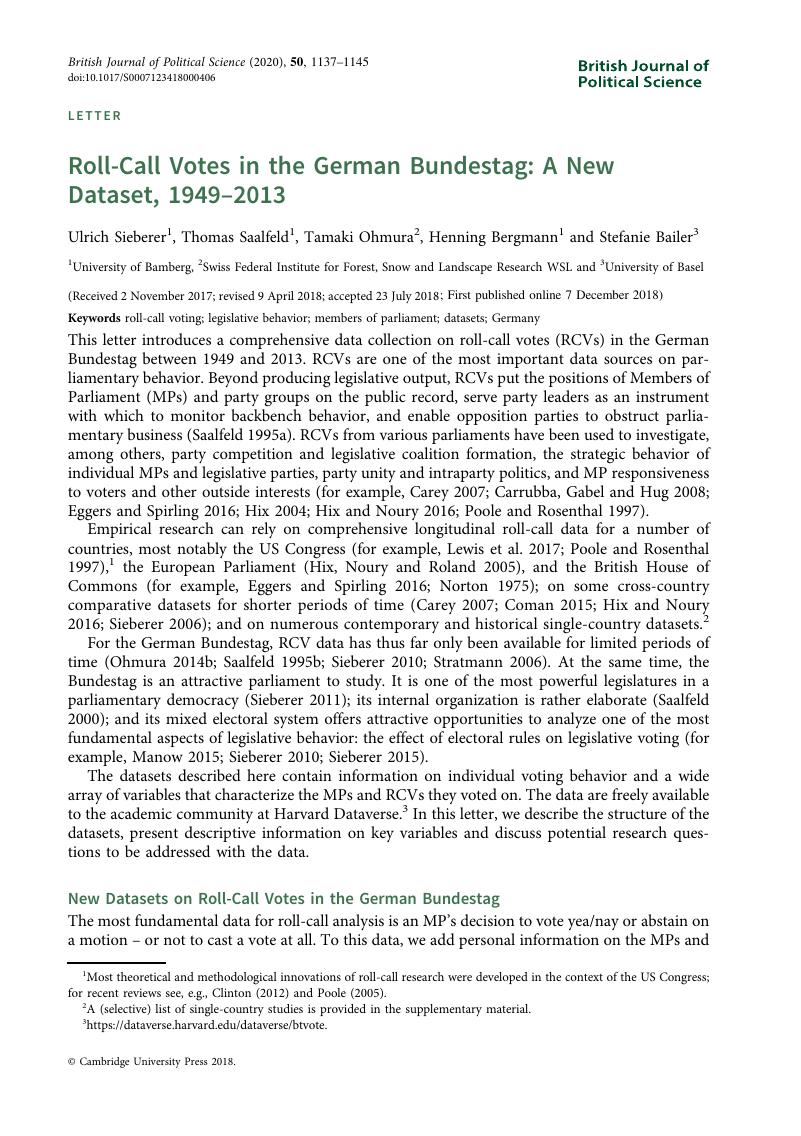Crossref Citations
This article has been cited by the following publications. This list is generated based on data provided by Crossref.
Gross, Martin
and
Jankowski, Michael
2020.
Dimensions of political conflict and party positions in multi-level democracies: evidence from the Local Manifesto Project.
West European Politics,
Vol. 43,
Issue. 1,
p.
74.
Höhmann, Daniel
2020.
When Do Men Represent Women’s Interests in Parliament? How the Presence of Women in Parliament Affects the Legislative Behavior of Male Politicians.
Swiss Political Science Review,
Vol. 26,
Issue. 1,
p.
31.
Hohendorf, Lukas
Saalfeld, Thomas
and
Sieberer, Ulrich
2020.
Continuity and Change of Party Democracies in Europe.
p.
309.
Haman, Michael
and
Školník, Milan
2021.
Politicians on Social Media. The online database of members of national parliaments on Twitter.
El profesional de la información,
Sieberer, Ulrich
and
Ohmura, Tamaki
2021.
Mandate type, electoral safety, and defections from the party line: The conditional mandate divide in the German Bundestag, 1949–2013.
Party Politics,
Vol. 27,
Issue. 4,
p.
704.
Hohendorf, Lukas
Saalfeld, Thomas
and
Sieberer, Ulrich
2021.
Veto power fosters cooperative behaviour: institutional incentives and government-opposition voting in the German Bundestag.
West European Politics,
Vol. 44,
Issue. 4,
p.
921.
Freitag, Julian
Kerkhof, Anna
and
Münster, Johannes
2021.
Selective sharing of news items and the political position of news outlets.
Information Economics and Policy,
Vol. 56,
Issue. ,
p.
100926.
Frank, Marco
and
Stadelmann, David
2021.
Political competition and legislative shirking in roll-call votes: Evidence from Germany for 1953–2017.
Public Choice,
Vol. 189,
Issue. 3-4,
p.
555.
Switek, Niko
2022.
The Legacy and Impact of German Unification.
p.
207.
Akirav, Osnat
2022.
Using non-legislative tools when legislation is hard: a comparison of the Canadian, UK, and Israeli parliaments.
British Politics,
Vol. 17,
Issue. 2,
p.
167.
Born, Andreas
and
Janssen, Aljoscha
2022.
Does a district mandate matter for the behavior of politicians? An analysis of roll-call votes and parliamentary speeches.
European Journal of Political Economy,
Vol. 71,
Issue. ,
p.
102070.
TUTTNAUER, OR
and
WEGMANN, SIMONE
2022.
Voting for Votes: Opposition Parties’ Legislative Activity and Electoral Outcomes.
American Political Science Review,
Vol. 116,
Issue. 4,
p.
1357.
Mai, Philipp
Link, Moritz
and
Engler, Fabian
2022.
Das Ende der Merkel-Jahre.
p.
101.
Mai, Philipp
2022.
Whose bread I don’t eat, his song I don’t sing? MPs’ outside earnings and dissenting voting behaviour.
Party Politics,
Vol. 28,
Issue. 2,
p.
342.
Göbel, Sascha
and
Munzert, Simon
2022.
The Comparative Legislators Database.
British Journal of Political Science,
Vol. 52,
Issue. 3,
p.
1398.
Schmuck, David
and
Hohendorf, Lukas
2023.
Loyal lists, distinctive districts: how dissent-shirking and leisure-shirking affect mixed-candidate selection.
West European Politics,
Vol. 46,
Issue. 7,
p.
1424.
Charnysh, Volha
and
Riaz, Sascha
2023.
After the Genocide: Proximity to Victims and Support for Punishing Ingroup Crimes.
Comparative Political Studies,
Mai, Philipp
Link, Moritz
and
Engler, Fabian
2023.
Voting Behaviour in the 19th German Bundestag and Beyond: Between the Daily Business of Unity and a Special Vote of Conscience.
German Politics,
p.
1.
Ohmura, Tamaki
and
Willumsen, David M.
2023.
Free votes and the analysis of recorded votes: evidence from Germany (1949–2021).
West European Politics,
Vol. 46,
Issue. 6,
p.
1205.
Hohendorf, Lukas
Sieberer, Ulrich
and
Wenzig, Jonas
2023.
Recorded votes as attention booster: How opposition parties use roll calls and nonrecorded votes for position taking in the German Bundestag, 2017–21.
Legislative Studies Quarterly,





